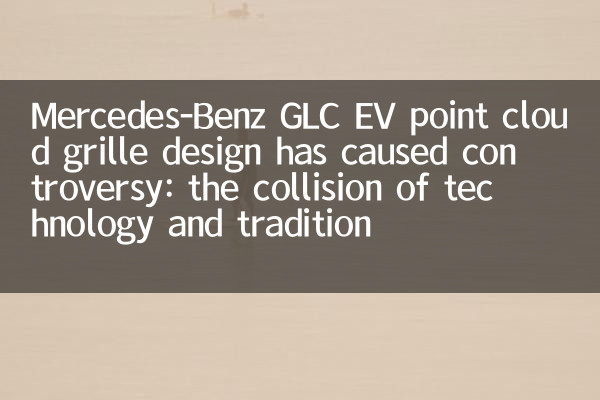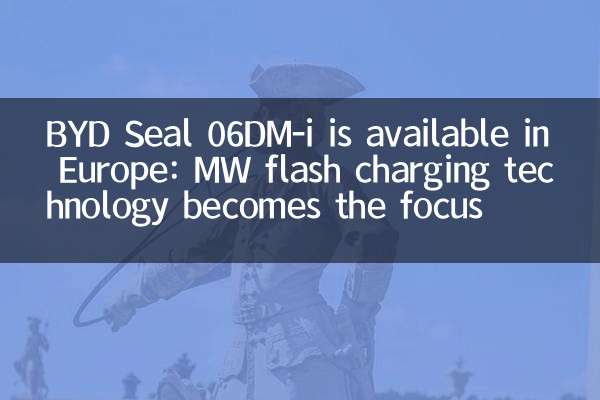Mercedes-Benz GLC EV point cloud grille design has caused controversy: the collision of technology and tradition
Recently, Mercedes-Benz's newly launched pure electric model GLC EV has sparked widespread discussion because of its unique "point cloud grille" design. This design breaks the grille shape of traditional fuel vehicles and adopts dense luminous dot matrix instead, which not only shows the sense of technology, but also retains the classic elements of Mercedes-Benz. However, this innovative design has produced polarized reviews among consumers and industry experts and has become one of the hot topics in the past 10 days.
1. Focus of controversy: the balance between sense of technology and traditional aesthetics

Supporters believe that the point cloud grille design is Mercedes-Benz's bold innovation in the era of electrification, reflecting the brand's exploration of future travel aesthetics. Opponents criticized it for losing the elegance and momentum of the Mercedes-Benz fuel vehicle era, which seemed too avant-garde and even "weird". Here are the main points of view on social media about the design:
| Opinion classification | Percentage | Typical comments |
|---|---|---|
| Support innovative design | 42% | "The electric era needs new language, and the point cloud grille is very futuristic" |
| Miss traditional design | 35% | "Lost the luxury aura of Mercedes-Benz, like a concept car" |
| Neutral viewing | twenty three% | "The actual car may have different effects and needs to be verified by yourself" |
2. Technical analysis: Functional design behind the point cloud grille
Mercedes-Benz officially explained that the point cloud grille is not simply decoration, but integrates a number of intelligent functions:
| Functional module | Technology implementation | User Value |
|---|---|---|
| Intelligent welcome system | LED dot matrix dynamically illuminates | Enhance the sense of human-vehicle interaction ritual |
| Driver Assistance Display | Light changes in specific areas | Prompt for autonomous driving status |
| Battery heat dissipation adjustment | Open and closed flow deflector | Optimize energy consumption efficiency |
3. Industry comparison: Front-face design trend of mainstream electric vehicles
By comparing GLC EV with competitors in the same level, we can find that each brand has adopted different strategies in electrification design:
| Brand model | Front face design features | Market feedback |
|---|---|---|
| Mercedes-Benz GLC EV | Point cloud glowing grille | More controversial |
| BMW iX3 | Enclosed double kidney grille | Highly accepted |
| Audi Q4 e-tron | Digital matrix grille | The sense of technology has received good reviews |
| Tesla Model Y | Completely grilleless design | Minimalist style fixed audience |
4. Consumer Research: The Impact of Design on Purchase Decisions
A survey of potential car buyers by a certain automobile platform showed that (sample size 2,000 people):
| Factors | Pay great attention | General attention | Don't care |
|---|---|---|---|
| Appearance design | 68% | 25% | 7% |
| Brand inheritance | 52% | 33% | 15% |
| Technology presentation | 47% | 38% | 15% |
5. Expert opinion: Design philosophy in the era of electrification
Professor Wang from the Institute of Automotive Design at Tsinghua University pointed out: "It is a fact that electric vehicles do not need air intake grilles, but luxury brands need to deal with the balance between historical heritage and innovation breakthroughs. Mercedes-Benz's choice reflects its 'electric first' strategy, but it may take time to adapt to this mutable innovation." Li Min, an analyst at the automotive industry, believes: "The dispute itself is a successful design strategy, which is better than no one discusses it, indicating that Mercedes-Benz still has the right to speak for design."
Conclusion: Brand identity in transformation reshaping
The grille controversy of the GLC EV reflects the general dilemma of the electrification transformation of traditional luxury brands. When "de-griding" becomes an industry trend, how to continue brand recognition through design language and convey an innovative image is a problem faced by every car company. Mercedes-Benz chose to redefine luxury with technology. This bold attempt will provide valuable experience to the industry regardless of success or failure. Ultimately, market sales and user reputation will give the most authentic evaluation.

check the details

check the details